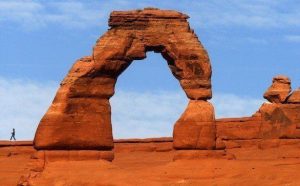
The Trump administration has canceled plans to open tens of thousands of acres for oil and gas drilling near three national parks in Utah next month, a victory for environmentalists and residents angered by its proposal.
In all, the Bureau of Land Management’s plans had called for more than 114,000 acres of federal land across southern Utah to be auctioned off in September, one of many lease sales across the West planned for the end of this year.
The Los Angeles Times reports that from the outset, the proposal generated fierce debate because most of the land — about 87,000 acres — is close to three of the state’s biggest tourist attractions: Arches, Canyonlands and Capitol Reef national parks.
Critics said that, under the original proposal, visitors in search of iconic views would instead be treated to a landscape crisscrossed by power lines, access roads and pipelines. In letters to the agency, local elected officials, tribal governments, environmentalists and those in the tourism business also worried about increasing air pollution and heavy truck traffic, as well as the long-term effects that more oil and gas development would have on a warming planet.
“All of these concerns run counter to the thriving outdoor community and high quality of life that has attracted many tourists and our residents,” Emily Niehaus, the mayor of Moab, Utah, wrote to the agency.
Elected officials in Grand County and Moab, the county seat, voted to oppose the lease sale. Local opposition caught the attention of state officials, who asked the bureau to reconsider its plans.
Environmental Protection Agency officials submitted a letter warning that the bureau’s environmental assessment of the lease sales pointed to the possibility of worsening air quality, less visibility and “increased risk of cancer.”
Bureau of Land Management officials on Tuesday said that, while most of the contested land would now be off-limits, they still plan to move forward with leasing more than 27,000 acres in other parts of the state.
Source: Los Angeles Times





